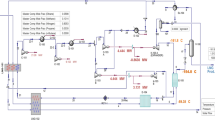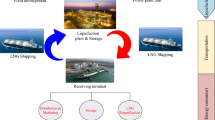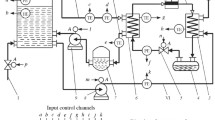Abstract
Ensuring safe and long-term storage of liquefied natural gas (LNG) is essential for improving the environmental and cost effectiveness of LNG-based power plants. A method for calculating heat fluxes from the environment to the working fluid in a cryogenic tank is proposed, taking into account the heat inputs through thermal bridges, including pipelines and supports of the internal vessel. In accordance with the calculations, performed for a tank with a volume of 6.8 m3, the average time of the LNG drainless storage in various modes of operation and refueling equals 6–8 days at an average heat flux of 396 W.
Similar content being viewed by others
Avoid common mistakes on your manuscript.
Introduction
A study of processes involved in the storage of cryogenic fuels (such as liquid hydrogen or liquefied natural gas (LNG)) is important for ensuring the long-term and safe storage of the fuel in a cryogenic tank under minimum evaporation losses.
A reduction in the heat flux from the environment to the working fluid (cryogenic fuel) is ensured using a screen-vacuum thermal insulation and evacuation of the cavity between the outer and inner vessels of the tank. Under these conditions, the main heat inputs are supplied to the working fluid through thermal bridges, such as fasteners of the inner vessel and elements of pipelines, through which the working fluid is fed to the cryogenic tank.
Thus, from the perspective of the heat flux analysis, the cryogenic fuel storage tank is a rather complex object and a mathematical description of such a system as a whole does not appear possible in practice.
In [1], based on the numerical simulation of the heat exchange process between LNG and the wall of the inner vessel at various levels of filling the tank, the regularities of variations in the operating parameters at the non-stationary mode of the system operation were determined.
A significant number of publications are devoted to the so-called “rollover”, i.e., a spontaneous mixing of liquids during the formation of two stratified layers. This is typically due to the insufficient mixing of the liquid with fresh LNG, which is added to residues that differ in temperature and density from the fresh LNG. At a rollover, the released vapors increase the level of pressure in the tank to the values that can be sufficient to trigger pressure relief valves. In this regard, rollover prevention devices are being developed [2]. The study of [3] proposes a mathematical description of the rollover process and provides the results of numerical simulations into determining the main parameters of the working fluid: pressure, temperature, and the amount of the formed boil-off gas. The paper [4] presents an experimental study aimed at determining the flow rate of the boil-off gas, generated during the rollover process using liquid nitrogen instead of LNG.
A number of publications address safety issues during the LNG storage, including the finite-element simulation of LNG leakage in a cryogenic tank [5], studies of the causes and consequences of accidents, caused by LNG leakages [6], as well as the studies of the flame formation by a horizontal LNG jet due to leakage [7].
The issues of a drainless LNG storage and a gas pressure increase over time are covered in [8].
Thus, most works provide the results of studying a single process ignoring the entire picture. However, for solving engineering problems, the calculation of the entire tank represents the greatest interest. Therefore, the present study aims to develop a calculation model of the cryogenic tank, taking the heat fluxes through thermal bridges into account.
The research object was a cryogenic tank with two vessels, separated by an evacuated space. The surface of the inner vessel is thermally insulated with 50 layers of aluminum foil (thickness of 0.15 mm), alternating with the layers of a non-woven material (thickness of 0.15 mm).
The tank scheme is shown in Fig. 1. The initial calculation data are provided in Table 1.
A cryogenic tank is a solid of a complex shape (a hollow cylinder of the shell with lids that are solids of revolution relative to a parabola), which complicates the process of deriving heat transfer equations. Therefore, in order to simplify the calculation, a cylindrical tank model (with the volume equal to the volume of a real tank with a complex shape) is adopted as the calculation model.
The parameters of the calculation model are presented in Table 2.
Mathematical model description
During LNG storage in a cryogenic tank, the following thermal resistances affect the value of the heat flux: the boundary between the outside air and the wall of the outer vessel; thermal conductivity through the wall of the inner vessel; radiation heat exchange through the vacuum cavity to the thermal insulation; thermal conductivity through the insulation; thermal conductivity through the wall of the inner vessel; heat transfer from the wall of the inner vessel to the LNG. Methods for calculating heat inputs through these thermal resistances are summarized in [9].
When determining the heat flux between the outer and inner vessels of the cryogenic tank (in addition to the heat fluxes directly through the vacuum cavity and the thermal insulation), it is also necessary to consider the heat fluxes, passing through the structural elements of the connection between the outer and inner vessels of the cryogenic tank.
The design of the cryogenic tank includes three types of such elements: daisy-type fasteners at the ends of the tank; fiberglass laminate supports at one of the tank ends; pipelines (Fig. 2).
The heat flux Qdaisy, transmitted through the daisy-type fastener plates, is determined as follows:
Where ndaisy = 10 is the number of plates; bdaisy is the width of the “daisy” plate; δdaisy is the thickness of the “daisy” plate; ldaisy is the length of the “daisy” plate; λsteel is the thermal conductivity of the plate material (12Kh18N10Т steel).
Equation 1 contains three unknown values: heat flux Qdaisy and temperatures at the ends of the “daisy” plates T2 and T3.
The cryogenic tank is installed on two fiberglass laminate supports, additionally representing thermal bridges between the vessels of the tank.
In this case, each support is installed on two channels, one of which is circular along the entire diameter of the tank, while the other is truncated. The main dimensions of channels and fiberglass laminate supports are given in Tables 3 and 4.
Expressing the heat flux through the channels and the support Qsupport, we obtain:
where λFGL is the thermal conductivity of the fiberglass laminate.
Next, let us determine the heat flux transmitted by the material of pipes in the longitudinal direction from the outer to the inner vessel of the cryogenic tank. A total of six pipes is located in the tank, pipe dimensions are given in Table 5.
The thermal conductivity of the pipe material and the temperature head for all pipes are the same; therefore, these parameters can be taken off the sum sign. Thus, we obtain a formula for a heat flux through the pipes Qpipe in the longitudinal direction from the outer vessel to the inner vessel of the cryogenic tank:
where i = 1–6 is the pipe number.
In addition to the heat flux due to the thermal conductivity of the pipes, heat exchange appears between the pipes and the working fluid in the pipes. In this case, the temperature head between the pipe material and the working fluid will be determined by a logarithmic dependence, while the heat transfer coefficients will differ for various pipes (due to different pipe dimensions and aggregate states of the working fluids in the pipes).
Expressing the temperature difference at the ends of the pipe, we obtain the dependence for the heat flux, directed from the pipes to the working fluid inside the pipes:
where αavi is the heat transfer coefficient between the pipe and the working fluid; x is the length of the pipe;
In Eq. 4, all values that are to the right of the sum sign are constant for each given pipe. The heat transfer coefficient is determined by the method described in [9].
Taking into account the methods of [9] and Eqs. 2–4, we obtain a system of 10 equations with 12 unknown values: T1, T2, T3, T4, \({T}_{2}^{\prime}\), Q, Q′, Qdaisy, Qsupport, Qpipe, Qpipe.gas, Qin, (here T1 is the outer surface temperature of the outer vessel; T4 is the inner surface temperature of the inner vessel; \({T}_{2}^{\prime}\) is the outer surface temperature of the insulation; Q is the total heat flux, supplied to the tank from the environment; Q′ is the heat flux from the radiation between the vessels; Qin is the heat flux through the inner vessel).
The remaining two equations are obtained from the heat balance equations for the outer vessel wall and LNG:
A system of 12 equations can be solved, e.g., in the MathCad software package.
As a result of solving the system of equations (Fig. 3), it was found that almost 90% of the heat flux accounts for the heat exchange between the pipes and the working fluid in the pipes.
Figure 4 illustrates the distribution of heat fluxes inside the cryogenic tank.
At the initial point of the LNG storage time, the heat flux from the environment to the LNG is Q = 423 W. However, during storage, the LNG temperature rises and the heat flux decreases.
Let us adjust the heat flux by the average LNG temperature during the entire shelf life:
where Tamb is the ambient temperature; TLNG is the temperature of the liquefied natural gas; \(T_{\mathrm{av}}=\left(T_{\mathrm{LNG}}+T_{\mathrm{LNG}1.6}\right)/2\) is the arithmetic mean temperature of the LNG, when the pressure rises from the initial value to a maximum pressure of 1.6 MPa (this value corresponds to the saturation temperature of the LNG equal to 162 K).
In further calculations, taking into account the adjustment, the value Q = 396 W was taken.
Calculation of the pressure increase in the tank during drainless LNG storage and the permissible degree of filling the cryogenic tank
At the onset of LNG storage, the main source of heat inputs is represented by the heat capacity of the cryogenic tank, rather than by the environment [10].
According to GOST R 56217, the calculation of the pressure increase in the tank during the drainless storage of LNG is carried out as follows. The time of the pressure increase from the initial to the final value (drainless storage duration) τ [h] is calculated by the formula:
where ψ is the degree of filling the tank with liquid; Ms is the mass of the liquid in the tank, kg; cs is the heat capacity of the liquid, we take cs = 3460 J/(kg·K) according to [11]; Mw is the mass of the tank walls, kg; cw is the heat capacity of the tank wall material, we take cw = 450 J/(kg·K) according to [12]; Ts is the final equilibrium temperature of the liquid, at a pressure of 1.6 MPa, Ts = 160 K according to [2]; Ts0 is the initial equilibrium temperature of the liquid at a pressure of 0.1 MPa, Ts0 = 111 K according to [2].
The degree of filling the tank is equal to the ratio of the filled liquid mass to the maximum mass of the liquid, which can theoretically be filled into the tank at a liquid density of 424 kg/m3:
When substituting the parameter values into expression (8), we obtain: τ = 123.59 h = 5.15 days.
The maximum permissible degree of filling the tank ψmax is calculated by the formula:
where \({\rho }_{m}^{\prime}\) is the density of the liquid at the maximum pressure value, kg/m3; \(\rho^\prime\) is the density of the liquid at the filling pressure, kg/m3.
According to [2], the density of the liquid at a pressure of 1.6 MPa is 335 kg/m3, then the maximum degree of filling the tank will be
According to expression (8), the heating time of the working fluid in the cryogenic tank is determined from the initial temperature to a predetermined saturation temperature. Let us transform expression (8) to obtain an analytical dependence of temperature in the tank on time (LNG storage time):
The obtained dependencies of the temperature and pressure in the cryogenic tank on the duration of LNG storage are shown in Figs. 5 and 6.
Conclusions
A method for evaluating heat fluxes from the environment to a cryogenic working fluid (LNG), located in a cryogenic tank, is proposed taking heat fluxes through thermal bridges and vacuum insulation into account. According to the results of calculations, the following was established:
-
most of the heat (89%) is transferred through the surface of pipelines to the working fluid in the pipelines;
-
for a tank with a volume of 6.8 m3, the average value of the heat flux from the environment to the working fluid equals 396 W;
-
the average duration of the LNG drainless storage (taking into account the heating of the working fluid by environmental heat fluxes) before the actuation of relief valves will be 5–8 days.
References
M.S. Khelifi-Touhami, A. Benbric, D. Lemonnier, D. Blay, Laminar natural convection flow in a cylindrical cavity application to the storage of LNG. J Petroleum Sci Eng 71, 126–132 (2001)
T.R. Mustafin, R.R. Gilmutdinov, Pre-mixing and mixing system of liquefied natural gas. Design, construction and operation of gas and oil pipelines and storages 5–6, 27–29 (2019)
B. Zhao, S. Han, L. Xu, et al, Rollover mechanism methodology of LNG tank with gas-liquid stratification based on curvelet finite element method and large eddy simulation technology. J Appl Fluid Mech 11, 779–786 (2018)
F. Perez, S. Ghafri, L. Gallagher, et al, Measurements of boil-off gas and stratification in cryogenic liquid nitrogen with implications for the storage and transport of liquefied natural gas. Energy 222, 119853 (2021)
H.D. Wei, M.Z. Zhou, Y.C. Zhang et al., Dynamic behavior of LNG storage tank during leakage conditions (The Twentieth International Offshore and Polar Engineering Conference, China, Beijing, 2010)
C. Yue, L. Chen, H. Xiang, et al, Assessment of cascading accidents of frostbite, fire, and explosion caused by liquefied natural gas leakage. Adv Civ Eng 2020, 1–14 (2020)
Z. Qian-xi, L. Dong, J. Wen, Experimental study of flashing LNG jet fires following horizontal releases. J Loss Prev Process Ind 57, (2018)
I.V. Barmin, Liquefied Natural Gas Yesterday, Today, Tomorrow, in Izd-vo MGTU im N.E, ed. by N.D. Kunis, (Baumana, Moscow, 2009)
Cryogenic Systems [In Russian], Textbook, In 2 Vols., Vol. 2. Fundamentals of designing devices, installations and systems, Gen. Ed. A.M. Arkharov and A.I. Smorodina, Mashinostroenie, Moscow (1999).
S.P. Gorbachev, V.P. Popov, M.V. Slavin, Determination of the cooling time of the cryogenic tank. Izvestiya Vysshykh Uchebnykh Zavedenii Mashinostroenie 5, 43–53 (2006)
GOST R 56021-2014. Natural Liquefied Combustible Gas. Fuel for Internal Combustion Engines and Power Plants. Technical Specifications [In Russian], Standartinform, Мoscow (2019).
V.S. Chirkin, Thermal Physical Properties of Nuclear Materials. Reference Book (Fizmatriz, Мoscow, 1959)
Funding
The results of the study were obtained with the financial support of the Ministry of Education and Science of Russia (project No. FSSS-2024-0017).
Author information
Authors and Affiliations
Corresponding author
Additional information
Translated from Khimicheskoe i Neftegazovoe Mashinostroenie, No. 8, pp. 33–36, 2023.
Publisher’s Note
Springer Nature remains neutral with regard to jurisdictional claims in published maps and institutional affiliations.
Rights and permissions
Springer Nature or its licensor (e.g. a society or other partner) holds exclusive rights to this article under a publishing agreement with the author(s) or other rightsholder(s); author self-archiving of the accepted manuscript version of this article is solely governed by the terms of such publishing agreement and applicable law.
About this article
Cite this article
Uglanov, D.A., Blagin, E.V., Gorshkalev, A.A. et al. Method for determining heat inputs and drainless storage duration of liquefied natural gas in a cryogenic tank. Chem Petrol Eng 59, 670–677 (2023). https://doi.org/10.1007/s10556-024-01290-0
Published:
Issue Date:
DOI: https://doi.org/10.1007/s10556-024-01290-0










